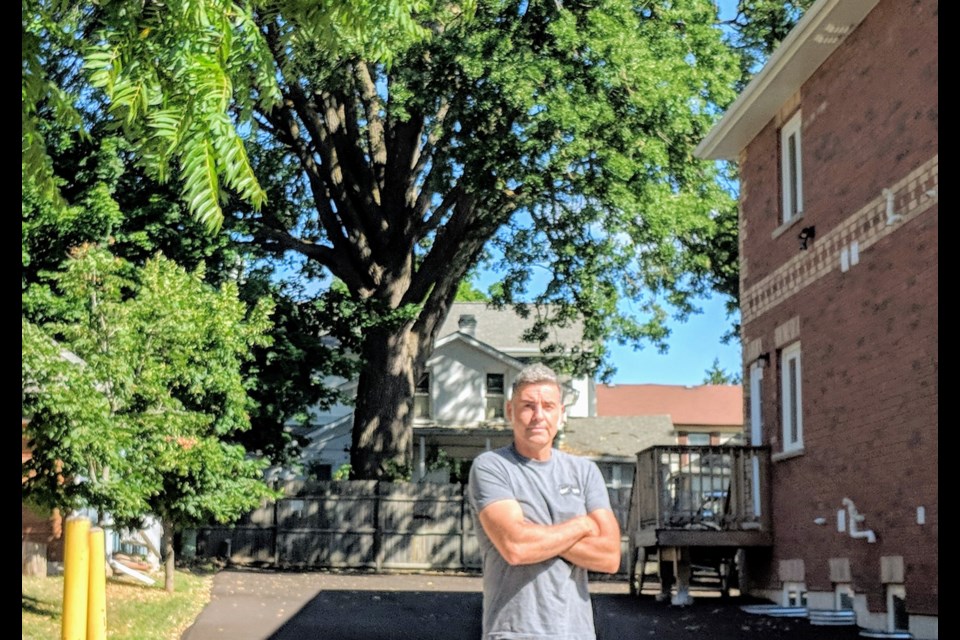If trees could talk, the three-centuries old white oak that towers above a Botsford Street heritage property, known as Liberty Hall, in Newmarket’s downtown might tell you that beneath its majestic branches local rebel sympathizers plotted and planned the details of the 1837 Rebellion in Upper Canada.
That tree, which received a heritage designation in 2005 and was named the Liberty Tree for its historical significance, would also be able to tell us the story of its sister tree, a centuries-old elm known as the Trading Tree that was removed in 1950, and was once located nearby on neighbouring Timothy Street from where it is said the name Newmarket came from, according to local historian Richard MacLeod.
Newmarket’s earliest settlers in the early 1800s gathered under the Trading Tree, a site known as the ‘meeting place’ that served as the first trading post of the then-community of New Market.
But now, it appears the long-lived gentle giant known as the Liberty Tree that soars at least 25 metres skyward is in distress, and one Newmarket resident is calling on the town to do right by it.
Resident Chris Howie, a software consultant who has lived in Newmarket since the 1970s, knows plenty about trees. Throughout his high school and university days, he ran a small tree care business in town.
For about the past five years, he has been a vocal advocate for a tree protection bylaw on private property, something which Newmarket does not have but its elected officials are now considering.
“This one caught my eye, I was walking by and I was shocked by what I saw,” Howie said.
The Liberty Tree, acknowledged as being the oldest tree left standing in Newmarket, is suffocating. About 35 per cent of its root system has been paved over to make room for a parking lot at a seven-unit housing complex located directly behind it at 443 Timothy St.
That’s a problem, Howie said, because the dripline roots, which form a sort of circumference around the tree, is where the most water and nutrients are absorbed. The roots have been pounded on by construction equipment, driven on by vehicles, and are buried beneath asphalt.
“The roots have a direct effect on the health of the tree, they’re the storage system, they need oxygen, water, fertilization, and all that’s been cut off,” Howie said. “Essentially, what needs to happen is that parking lot has to get dug up.”
Howie first notified Newmarket council about the health of the Liberty Tree during a June deputation he made at the municipal offices to push the town to close a loophole in its tree policy that makes it possible for developers to clear-cut land in advance of submitting a building application, with no repercussions.
Some of the Liberty Tree’s branches have begun to die and it is in desperate need of pruning, Howie said, adding that he has offered to do the work at no charge because the deadwood attracts insects and bugs and is a point of entry for disease.
“This is a piece of our heritage, it’s irreplaceable,” he said. “This tree is already at the upper span of its life and the last thing it needs is stress like this. We’re already having hotter summers, drier summers, we’re getting rain but it’s coming all at once, which usually means the water doesn’t soak into the root system.”
“Why do I need to be the tree police here?” Howie said. “The town needs an inspector to hold these builders accountable. It’s clear the town didn’t ask the builder to stay away from the tree’s roots. The planning department has failed us and the town needs to act.”
Newmarket Mayor John Taylor said he has taken a personal interest in ensuring the health of the Liberty Tree and the town will set up a meeting in the near future with both property owners on Botsford and Timothy streets to find a resolution.
Taylor admitted the situation is “a complicated one”, as the tree is on private property, as well as the parking lot that now covers its roots.
“We’ve already started to look at what possible remediation work can be done,” he said.
For historian MacLeod, who conducts heritage walks around Newmarket, the Liberty Tree is always on the day’s tour.
“It’s a glorious tree, regardless of its historical relevance, and is always worth saving,” he said.
